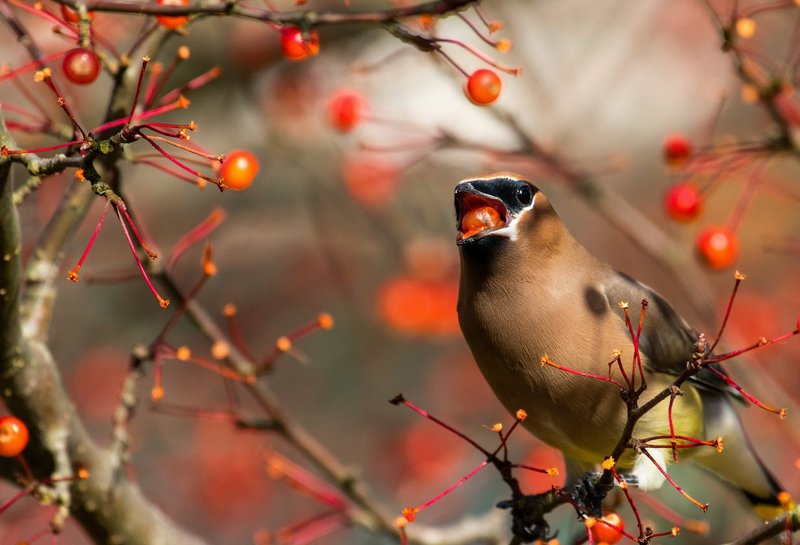The arrival of crisp fall weather has gardeners thinking about the winter, a period of retreat in the garden but not of death.
The plants' withdrawal from the cold invites close examination of the leafless world. But if you need something beyond the display of holly berries, the smooth silver bark and latent buds of the magnolia, or the black silhouette of an old walnut tree, there is another, more vivid reminder that life goes on outdoors. We have the birds.
Or do we?
A study by ornithologists and other scientists released in September told us bird populations have crashed. Since 1970, the United States and Canada have lost nearly 3 billion, close to 30% fewer individuals. The losses are across habitats and species, though hardest hit are birds that inhabit the grasslands from Texas north into the Canadian prairie. The suspected causes? Habitat loss, more intensive agriculture and greater use of pesticides that kill the insects that birds eat.
For those of us who see the garden not just as a living expression of beauty but a place where we embrace nature, the news is a reminder that we have some power to mitigate this distressing loss.
First and foremost, keep the cat indoors. Ask your neighbor to do the
same. Cat predation is a major cause of bird mortality, according to the American Bird Conservancy. This is not just from pets but all the alley cats out there, themselves the product of people throwing unwanted, unsterilized felines to the four winds. The cats are the instrument of bird death, but we are the cause.

Songbirds also die in large numbers by flying into windows. If this is a problem where you live, you can attach decals to your glazing. Another tactic is not to use pesticides, even sprays against mosquitoes, a pest best countered by removing sources of standing water, especially in the spring.
You might think the greatest step you can take for the birds is to feed them. This is, after all, the time of year our thoughts turn to nourishing birds through the chillier months ahead.
Do the birds need this buffet? Perhaps not, but bird feed can help at key moments in the year, in April and May and September and October, when migrating birds need all the fuel they can get. "These movements mean a high expenditure of energy for what are often tiny animals," said Emma Greig, program leader of the Cornell Lab of Ornithology's Project Feeder Watch. "To have places along the way for them to rest and feed, that's really important."
The other moment is in winter during periods of extreme cold. These sudden Arctic blasts can lead to a lot of bird death. Suet blocks work for insect-feeding birds "and are used by a wide variety of species," Greig said. "They're ideal for cold weather, the time when bird feeders actually enhance survival of some species."

The greatest value of bird feeding is to bring wild birds in proximity to us, so we can develop an affinity for them.
Not all mixes are equal. Striped sunflower, for example, is not favored by as many bird species as black-oil sunflower or hulled or chipped sunflowers, according to a three-year study, Project Wildbird. Project FeederWatch (feederwatch.org) has put together an infographic on common feeder birds and what their preferences are.
Placement of feeders can be important — near shrub cover, but not where a stalking cat can hide, and close to a window, which will actually minimize window-strikes when birds seek cover from a swooping hawk, Greig said.
If you really want to help birds, though, the way to do it is to mindfully develop your garden as a habitat where birds can find what they need to nest and raise young: food, cover and water year-round. One element of this is to not use pesticides. Another is to reduce the area of lawn in favor of bird-friendly plants.

At the Audubon Naturalist Society's 40-acre Woodend Nature Sanctuary in Chevy Chase, Md., various projects in recent years have been implemented to improve avian habitats. A signal project is the conversion of a quarter-acre field of orchard grass into a native plant meadow of grasses and wildflowers. This draws and harbors insects, which many birds need to feed themselves and their young.
Another display is the Blair Native Plant Garden, which shows garden-worthy plants found in the Appalachian Mountains, the Piedmont and the coastal plain.
Another approach is to layer planting — ground covers, shrubs, trees — in a way that mimics natural areas and provides birds with the undergrowth they need, said Alison Pearce, the society's director of restoration. In such gardens, expect to see wood thrushes and eastern towhees.
The society has put together a guide for homeowners to build their own habitats at ANShome.org. Pearce encourages interested individuals to visit the sanctuary.
The type of trees and shrubs you choose can also make a big difference to birds. Winterberries, American hollies and other Ilex provide important sources of winter berries. I used to have a February flock of cedar waxwings on my hollies; later the same trees drew plundering flocks of robins.
In the dead of winter, the robins provided their own form of vital entertainment but also a sense that nothing is static in the garden, that one season is always foreshadowing the next.

Extra gardening tip:
Compost piles that have dried out will stop decomposing. Rake out materials and mix with fresh, chopped yard waste and shredded leaves. Return the contents to the pile and soak the materials. Keep the pile from getting waterlogged. Evenly moist is the way to go.
HomeStyle on 11/09/2019
